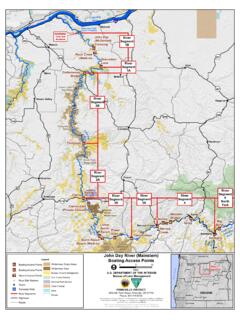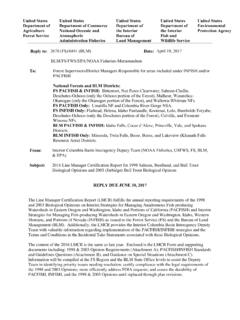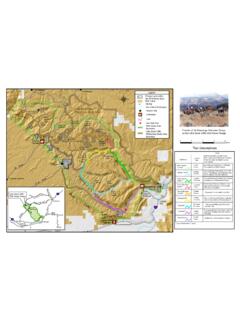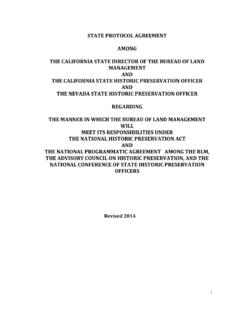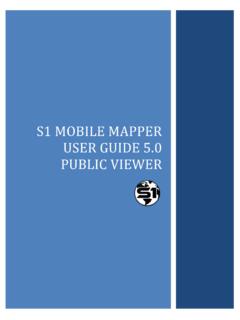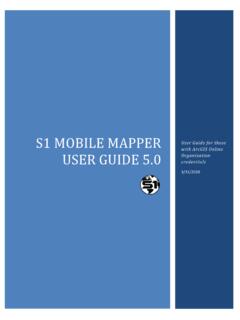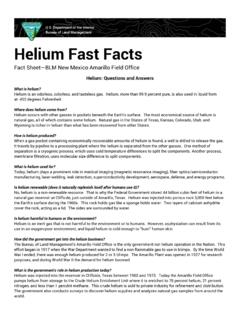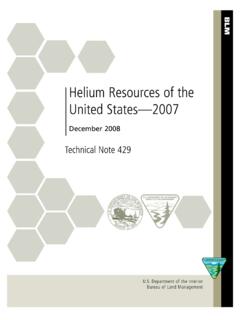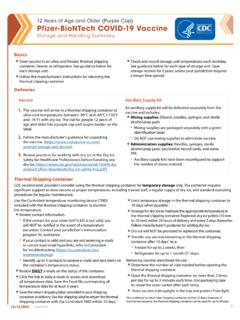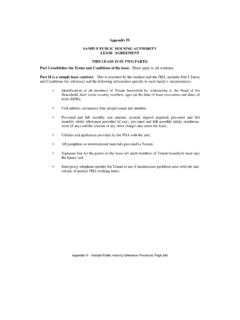Transcription of Collecting on Public Lands - Bureau of Land Management
1 The Public Lands offer a broad range of outdoor activities that include Collecting resources such as firewood, gemstones, pine nuts and fossils for personalenjoyment and use. This is a summary of what may becollected from Public Lands . The BLM encourages peopleto explore the nearly 48 million acres of Public land in onPublic LandsPlease use care in Collecting . Avoid activities which damage Public resources such as vegetation, scenery and archaeologicalsites, or which create hazardous conditions such as pits or trenches. Power equipment and explosives may not be used except for woodcutting and certain dredging amounts of the following may be collected for non-commercial purposes: Flowers, berries, nuts, seeds, cones, and other plant parts.
2 Campfire wood. Rocks, mineral specimens, common invertebrate fossils and semiprecious gemstones. ExceptionsExceptions include specifically protected plants, campfire wood in posted areas, wildernessareas, wilderness study areas, areas of critical environmental concern including Stewart Valley,near Gabbs, Nev., Red Rock Canyon and Sloan Canyon National Conservation Areas, historicandprehistoric sites and districts, and national natural landmarks. Maps and information onspecific restrictions are available at Bureau of land Management (BLM) offices in Las Vegas,Tonopah, Carson City, Reno, Winnemucca, Battle Mountain, Elko, Ely and and silver may be prospected for with hand tools including pans and metal such as gold, silver and opals found on mining claims belong to the claim claim records may be viewed at BLM and county recorder offices.
3 Sluicing, dredgingandcommercial mining require permits. Recreational panning which does not involve mechan-ical equipment is permitted in wilderness and wilderness study areas if it does not create sur-face disturbance or impair the minerals, such as sand, gravel, cinders, topsoil and other common mineral materials must be purchased by prior arrangementwith the and common rock speci-mens may be collected for private useon unclaimed production of commonrocks on an unclaimed site requires a permit. Only hobby Collecting is allowed in wildernessand wilderness study areas and must not involve surface disturbance. Collection of prehistorictools and chips made of precious or semiprecious stones is not fossils such as dinosaurs, mammals, fishes and reptiles, and uncommon inverte-brate fossils may be collected only by trained researchers under BLM permit.
4 Collected fossilsremain the property of all Americans and are placed withmuseums or other Public institutions after study. Common invertebrate fossils such as plants, mollusks, and trilobites may be collected for personal use in reasonablequantities, but maynot be bartered or sold. Petrified wood may be collected up to 25 pounds plus onepiece per person per day, with a maximum of 250 pounds perperson per year. Permits are required for pieces over 250pounds. Petrified wood may not be traded, bartered or soldwithout resources, including plant, animal and geologic fea-tures, are federally protected and may not be altered, damagedor removed. Cultural ArtifactsCultural materials on Public Lands may not be removed, damaged, disturbed, excavated ortransferred without BLM permit.
5 Cultural resources include prehistoric and historic artifactsand sites, broken objects and debris more than 100 years old that were used or produced byhumans. Protected materials include arrowheads and other stone tools, grinding stones,beads, baskets, pottery, old bottles, horse shoes, metal tools, graves and trash scatters. Historic sites such as cabins, sawmills,graves, trail traces, mining areas, townsites,ranches and railroads are notopen tocollecting. Metal detector use is allowed on publiclands. Modernmoney may be collected,but coins and artifacts more than 100years old may not be , Plants and Pine NutsVarious species of trees are available for firewood with apersonal use permit, which allows the cutting of up to 10cords per family per year in specified areas for a nominal for woodcutting are required even on an individual smining or exploration of dead and down wood for immediate campfire use is allowed except for posted sites.
6 Christmas tree permits are available for a nominal fee during the holiday season. Check with local BLM offices for permits and tree cutting area amounts of plants, plant parts, seeds, flowersandberries may be collected for personal use in most , yuccas, succulents and evergreen shrubs and trees areprotected by the state. Species listed as threatened or endangered are protected by the federalgovernment and may not be collected without permit. Collection of species listed as sensitiveor candidates for threatened or endangered status should be avoided. Pine nuts in amounts up to 25 pounds per person per year may be collected for non-commercial use. Although there are some designated commercial Collecting areas, these are fully open to the Public as well.
7 Harvesting plants or plant materials such as seeds, pine nuts, landscaping materials, firewood and timber for commercial purposes requires a or harvest of game and nongame animals, including fish, is regulated by theState and the Fish and Wildlife Service. Information for hunters, trappers, fishermenand collectors is available from the Nevada Division of and endangered species, including desert tortoise and some other reptiles,whether federal or state listed, may be collected only under permit from the Fish andWildlife Service or state of Nevada. Lahontan cutthroat trout may be taken with a Nevadafishing license in permitted areas and seasons. Lists of protected species are available from the Fish and Wildlife Service, the Nevada Division of Wildlife and BLM , free-roaming horses and burros may not be harassed, harmed, collected or soldunder any circumstances.
8 Their water sources are also protected. Wild horses and burrosgathered under BLM supervision and prepared for private ownership may be adoptedfrom the of regulations under the Federal land Policy andManagement Act, the Native American Graves Protection andRepatriation Act, the Archaeological Resources Protection Act, state and federal wildlife law, and other laws may be punishable by fines, imprisonment, and forfeiture of equipment and vehiclesused in commission of the OUTANDSTAY ALIVE!Abandoned minesare dangerous emandleave emArtifacts belong on Public Lands .
